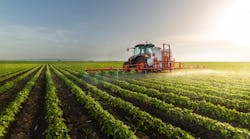During the summer of 1962, The New Yorker ran three excerpts from an upcoming book called "Silent Spring" by a former marine biologist named Rachel Carson. Then that September, Houghton Mifflin Co. released the book. The world hasn't been the same since. Many observers agree that "Silent Spring" spurred the creation of the modern environmental movement and caused the public to view pesticide makers specifically and the chemical industry generally in a more critical light.
Chapter 1, A Fable for Tomorrow, presents a foreboding scenario — a town in America robbed of its vitality by the thoughtless actions of its people. Birds had disappeared, fish had died, and plants and trees had withered. Chapter 3, Elixirs of Death, explains how this could happen. It starts: "For the first time in the history of the world, every human being is now subjected to contact with dangerous chemicals, from the moment of conception until death." Carson is railing against the unchecked use of synthetic pesticides, particularly DDT (dichlorodiphenyltrichloroethane). The chapter ends: "We are rightly appalled by the genetic effects of radiation; how then, can we be indifferent to the same effect in chemicals that we disseminate widely in our environment?"
At that time, the U.S. government approved pesticides without long-term studies of their effects. Moreover, in that more-innocent era, the general public largely considered scientific developments as innately positive. (Perhaps you remember that through the early 1960s Dupont used the slogan: "Better things for better living through chemistry.")
"Silent Spring" challenged that. And it wasn't authored by an irrational firebrand, although some scientists and executives in the chemical industry at the time tried to dismiss her as one.
Carson had received an MA in zoology from Johns Hopkins University and taken a job as a marine biologist at the U.S. Fish and Wildlife Service, eventually becoming chief editor of its publications. However, her heart was in science writing.
In 1951, her second book, "The Sea Around Us," propelled her into the top ranks of science writers. It remained on the New York Times Best Seller List for over a year and a half and won the National Book Award for nonfiction. Its favorable reception prompted re-publication of her first book, "Under the Sea Wind," which had disappointing sales when it first came out in 1941 but now became a hit. Their success gave her the financial security to become a full-time writer. Her follow-up book, 1955's "The Edge of the Sea" also was a best seller.
Carson had been concerned since the mid-1940s about the dangers of broad-spectrum pesticides like DDT, which affect numerous species, not just one or two targeted pests, but couldn't interest a publisher in the topic then. Her desire to write about the threats of DDT were revived in 1958 when she received a letter from a friend in Massachusetts citing the death of birds from DDT spraying. This spurred a four-year effort culminating in the publication of "Silent Spring." The book references a massive amount of scientific information — several hundred papers are cited; relevant specialists reviewed most of the chapters dealing with scientific findings.
"Silent Spring" aroused intense public interest, becoming a "Book of the Month Club" selection and spurring a television special. Some leading technologists at companies in the chemical industry immediately challenged her contentions, and tried to discredit her research. However, she did have prominent defenders in academia and elsewhere. The controversy simply wound up drawing more attention to the book, boosting its sales and bolstering support for her position that use of pesticides demands care and attention to their long-term impact.
Carson died in 1964 but not before energizing the environmental movement, which succeeded several years later in getting the U.S. to largely phase out use of DDT. She posthumously received the Presidential Medal of Freedom, one of the U.S.'s highest civilian honors, in 1980.
"Silent Spring" has profoundly and positively impacted our world, sensitizing people to the importance of responsible use of chemicals. It also has benefited our industry, making manufacturers more concerned about the long-term effect of their products and, beyond that today, the impact of their operations.
Source: Shutterstock.

Latest from Environmental Health & Safety
Latest from Environmental Health & Safety